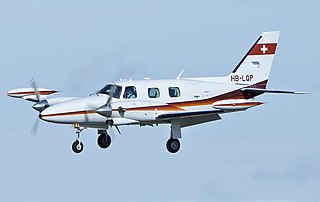
The Handley Page HP.137 Jetstream is a small twin-turboprop airliner, with a pressurised fuselage. The aircraft was designed to meet the requirements of the United States commuter and regional airline market. The design was later improved and built by British Aerospace as the BAe Jetstream 31 and BAe Jetstream 32, featuring different turboprop engines.

The Pilatus PC-6 Porter is a single-engined STOL utility aircraft designed by Pilatus Aircraft of Switzerland. First flown in 1959, the PC-6 was produced at Pilatus Flugzeugwerke in Stans, Switzerland. It has been built in both piston engine- and turboprop-powered versions, and was produced under licence for a time by Fairchild Hiller in the United States. After 604 deliveries in 63 years, Pilatus ended production in 2022.

The Embraer EMB 121 Xingu is a twin-turboprop fixed-wing aircraft built by the Brazilian aircraft manufacturer, Embraer. The design is based on the EMB 110 Bandeirante, using its wing and engine design merged with an all-new fuselage. The EMB 121 first flew on 10 October 1976.

The Piper PA-31T Cheyenne is a turboprop development of the earlier PA-31P Pressurized Navajo.

The Aérospatiale N 262 is a French twin-turboprop high-wing airliner built first by Nord Aviation. The aircraft was also known as the Nord 262.

The Turbomeca Astazou is a highly successful series of turboprop and turboshaft engines, first run in 1957. The original version weighed 110 kg (243 lb) and developed 240 kW (320 shp) at 40,000 rpm. It was admitted for aviation service on May 29, 1961, after a 150-hour test run. The main developing engineer was G. Sporer. It was named after two summits of the Pyrenees.

The Air Tractor AT-500 is a family of agricultural aircraft that first flew in the United States on 25 April 1986, manufactured by Air Tractor Inc. Of monoplane low-wing, taildragger configuration, they carry a chemical hopper between the engine firewall and the cockpit. Compared with their predecessor, the AT-500 family mostly feature a wingspan increased to 50 ft, and an additional fuselage stretch of 22 in (56 cm), allowing for a larger chemical hopper. Almost all variants offer a widened "buddy" seat or a tandem seat for a passenger, observer, or loader; trainer aircraft with full dual controls have also been offered.

The Breguet 941 was a French four-engine turboprop short takeoff and landing (STOL) transport aircraft developed by Breguet in the 1960s. Although widely promoted, both by Breguet in France and by McDonnell Aircraft and McDonnell Douglas in the United States, it was not built in large numbers; only one prototype and four production aircraft were built.
The Dassault M.D.320 Hirondelle was a French 14-seat utility transport aircraft of the 1960s, designed and built by Dassault Aviation, in prototype form only.

The Fouga CM.10 was an assault glider designed for the French Army shortly after World War II, capable of carrying 35 troops, later converted as a powered transport.

The Dassault MD.415 Communauté was a 1950s French twin-engined light turboprop transport monoplane built by Dassault Aviation. Only one prototype was built and flown.

The Nord 1100 Noralpha was a French-built and re-engined Messerschmitt Bf 108 produced by Nord Aviation.
The Nord 2100 Norazur was a 1940s French military transport monoplane designed and built at Courbevoie near Paris by SNCAN.
The Bréguet 890 Mercure was a late 1940s French cargo and passenger transport aircraft designed by Bréguet Aviation. Three variants were produced including a military variant called the Mars but none entered production.

The SIPA S.251 Antilope was a low-wing monoplane, seating four or five and powered by a single turboprop engine, developed in France in the early 1960s. It set a number of class records but was not put into production.

The Short SC.7 Skyvan is a British 19-seat twin-turboprop aircraft manufactured by Short Brothers of Belfast, Northern Ireland. It is used mainly for short-haul freight and skydiving.

The Nord 260, built in prototype form as the Max Holste MH.260 Super Broussard,, was a turboprop-powered, uprated version of the piston-engined Max Holste MH.250 Super Broussard, that was further developed into the Aérospatiale N 262.

The UTVA Kobac was a prototype Serbian single-engine, low-wing tandem-seat turboprop training/light attack aircraft manufactured by Pančevo based UTVA Aviation Industry, and designed by the Military Technical Institute. Revealed as a mockup on 02 September 2012 during the Batajnica 2012 Air Show, the aircraft's first flight was planned for 2013, but was never realized.
The Morane-Saulnier MS-700 Pétrel was a French four-seat cabin-monoplane designed and built by Morane-Saulnier, only three prototypes were built.
The Hurel-Dubois Miles HDM.105 was a transport aircraft fitted with very high aspect ratio wings for research purposes, building on research carried out with the Hurel-Dubois HD.10, and a stepping point to the planned production HDM.106 Caravan. The HDM.105/HDM.106 provided the starting point for the design of the Short SC.7 Skyvan.
















